IBM数据仓库解决方案 - 通用版
- 格式:ppt
- 大小:15.58 MB
- 文档页数:58
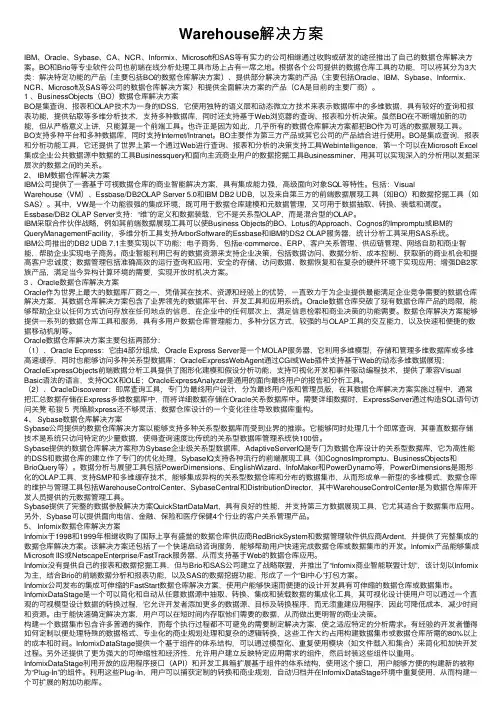
Warehouse解决⽅案IBM、Oracle、Sybase、CA、NCR、Informix、Microsoft和SAS等有实⼒的公司相继通过收购或研发的途径推出了⾃⼰的数据仓库解决⽅案。
BO和Brio等专业软件公司也前端在线分析处理⼯具市场上占有⼀席之地。
根据各个公司提供的数据仓库⼯具的功能,可以将其分为3⼤类:解决特定功能的产品(主要包括BO的数据仓库解决⽅案)、提供部分解决⽅案的产品(主要包括Oracle、IBM、Sybase、Informix、NCR、Microsoft及SAS等公司的数据仓库解决⽅案)和提供全⾯解决⽅案的产品(CA是⽬前的主要⼚商)。
1 、BusinessObjects(BO)数据仓库解决⽅案BO是集查询、报表和OLAP技术为⼀⾝的IDSS,它使⽤独特的语义层和动态微⽴⽅技术来表⽰数据库中的多维数据,具有较好的查询和报表功能,提供钻取等多维分析技术,⽀持多种数据库,同时还⽀持基于Web浏览器的查询、报表和分析决策。
虽然BO在不断增加新的功能,但从严格意义上讲,只能算是⼀个前端⼯具。
也许正是因为如此,⼏乎所有的数据仓库解决⽅案都把BO作为可选的数据展现⼯具。
BO⽀持多种平台和多种数据库,同时⽀持Internet/Intranet。
BO主要作为第三⽅产品或其它公司的产品结合进⾏使⽤。
BO是集成查询,报表和分析功能⼯具,它还提供了世界上第⼀个通过Web进⾏查询、报表和分析的决策⽀持⼯具Webintelligence,第⼀个可以在Microsoft Excel 集成企业公共数据源中数据的⼯具Businessquery和⾯向主流商业⽤户的数据挖掘⼯具Businessminer,⽤其可以实现深⼊的分析⽤以发掘深层次的数据之间的关系。
2、 IBM数据仓库解决⽅案IBM公司提供了⼀套基于可视数据仓库的商业智能解决⽅案,具有集成能⼒强,⾼级⾯向对象SQL等特性。
包括:VisualWarehouse(VM)、Essbase/DB2OLAP Server 5.0和IBM DB2 UDB,以及来⾃第三⽅的前端数据展现⼯具(如BO)和数据挖掘⼯具(如SAS)。

ibm数据管理解决方案|元鼎时代篇一:IBM数据仓库解决方案(简)技术架构设计成功地实施一个仓库项目,通常需要很长的时间。
如果仅仅着眼于短期成果,缺乏整体考虑,采用一种不健全的体系结构,不仅会增加系统开发和维护成本,而且必将对发挥数据仓库的作用造成不利的影响。
因此一个综合,清晰的远景规划及技术实施蓝图将在整个项目的实施过程中起到重要作用。
技术架构必须具有高度先进性和可扩展性,以满足业务需求的不断变化。
一个完整的数据仓库系统包括数据源、数据转换区、数据仓库、数据集市、和数据展现层,通过数据仓库不同层次之间的加工过程,实现财政从数据资产向信息资产的转化过程。
在不同层次之间的数据加工过程需要通过ETL技术实现,并对整个过程进行有效的元数据管理。
基于对需求的理解,基于财政部的信息系统框架模型基础之上的财政决策支持系统技术架构如下图(来自: 小龙文档网:ibm数据管理解决方案|元鼎时代)所示:如上图所示意,通过搭建灵活的、可扩展技术架构,在保持数据集市稳定性的同时,可以不断增加数据源,增加应用数据层、增加应用层,满足不断增加的业务分析应用需求。
采用DW+ODS的数据仓库体系结构,使用全新的ETL模式对ODS进程每日数据更新,按周或月周期对数据仓库执行ETL过程。
使用COGNOS BI做为前端的查询分析和数据挖掘工具,可满足各种日常数据处理操作,从即时简单报表查询到多维多级数据分析和挖掘,都能够在统一COGNOS BI平台上完成。
数据源和数据接口数据源指存储于财政各个业务系统的业务数据,以及未来的财政监管和外部数据。
数据仓库系统将整合来自于这些系统的数据,形成财政统一的、一致的基础数据集,并提供给不同的应用主题形成数据集市。
各个系统在体系架构、开发平台、数据定义、接口标准都会存在不同程度的差异;另外由于业务的不断变化,历史数据与当前数据之间的含义也可能存在不同,因此数据整合必须充分考虑源系统在技术和数据方面存在的差异。

商业智能(BI)方案目录1. 企业异构数据源32. ETL数据抽取转化和加载42.1 数据抽取、转换和加载52。
2 统一调度62。
3 监控72。
4 ETL工具OWB73. 数据仓库83。
1 操作型数据93.2数据集市93.3 联机在线分析OLAP93。
4 数据挖掘104。
前端展现114.1 多维分析工具Powerplay124.1.3 PowerPlay 应用开发过程164。
2 企业报表ReportNet164。
3 KPI企业关键指标254。
4 报表预警与分发264。
5 即席查询27商业智能(BI, Business Intelligence)是对商业信息的搜集、管理和分析的过程,目的是使企业的各级决策者获得知识或洞察能力,促使他们做出对企业更有利的决策。
商业智能一般由数据仓库、数据分析、数据挖掘、在线分析、数据备份和恢复等部分组成。
其基本体系结构包括数据仓库、多维分析和数据挖掘等三个部分。
其中数据仓库用于抽取、整合、分布、存储有用信息;多维数据分析可全方位了解现状;数据挖掘则是发现问题、找出规律、预测将来,达到真正的智能效果。
商业智能的过程:从不同的数据源收集的数据中提取出有用的数据,对数据进行清理以保证数据的准确性,将数据经过转换、重构后存入数据仓库或数据集市,然后寻找合适的查询和分析工具,数据挖掘工具,OLAP工具对信息处理,最后将知识呈现于用户面前,转变为管理、决策.商业智能是从传统的业务过程扩展到对业务数据的联机分析、并从中得到各种面向主题的统计信息和经过计算的结论的应用系统,其处理模式称之为联机分析处理 (OLAP),它的核心是数据仓库技术.其常见的体系结构如下图所示:操作型数据TransformationBI系统架构商业智能已经成为今天商业环境中一个必要因素,企业需要权衡今天商业智能技术提供的能力来保持和提高竞争性和可赢利性。
先进的BI(商业智能)系统解决方案通过开放、易扩展的平台为企业提供管理信息和运营信息的快速获取、集成和智能化分析手段,可以广泛地应用于金融、电信、税务、保险等行业。
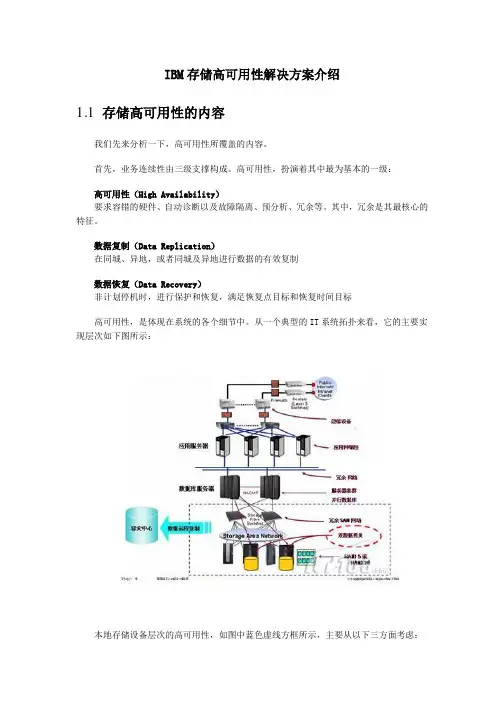
IBM存储高可用性解决方案介绍1.1 存储高可用性的内容我们先来分析一下,高可用性所覆盖的内容。
首先,业务连续性由三级支撑构成。
高可用性,扮演着其中最为基本的一级:高可用性(High Availability)要求容错的硬件、自动诊断以及故障隔离、预分析、冗余等。
其中,冗余是其最核心的特征。
数据复制(Data Replication)在同城、异地,或者同城及异地进行数据的有效复制数据恢复(Data Recovery)非计划停机时,进行保护和恢复,满足恢复点目标和恢复时间目标高可用性,是体现在系统的各个细节中。
从一个典型的IT系统拓扑来看,它的主要实现层次如下图所示:本地存储设备层次的高可用性,如图中蓝色虚线方框所示,主要从以下三方面考虑:冗余SAN网络SAN交换机冗余配置,主机光纤通道卡、存储光纤接口双配置,冗余连接等。
这部分设计用于防范通道、接口和网络的单点故障。
存储设备个体高可靠除普遍支持RAID保护技术外,目前的部分高端企业级存储,还采用全冗余设计、镜像缓存等技术来进行自身保护。
这部分设计和使用,侧重在于保证存储设备单个个体内的数据安全。
当存储设备出现全面故障,不能运转时,最多只能保证“数据不丢失”,不能支持“数据持续访问”。
双存储设备如上图中红色虚线部分所示,配置双磁盘设备,存放双数据拷贝。
保证在单个存储服务器出现故障时,首先实现数据不丢失,其次实现业务的连续运行。
在这三方面中,冗余SAN网络、存储设备个体高可靠相对为人所熟悉,不再赘述。
下面所谈的存储高可用性方案重点,将集中在“双存储设备”的环节上。
1.2 存储高可用性方案的主要实现方式存储高可用性方案的主要实现方式:磁盘设备间数据镜像和磁盘设备间数据复制。
图:存储高可用性方案实现方式1.2.1 磁盘设备间数据镜像通过Power服务器的LVM(逻辑卷管理)技术,在两套IBM System Storage磁盘设备间(DS8000/DS5000/DS4000),建立数据镜像关系。
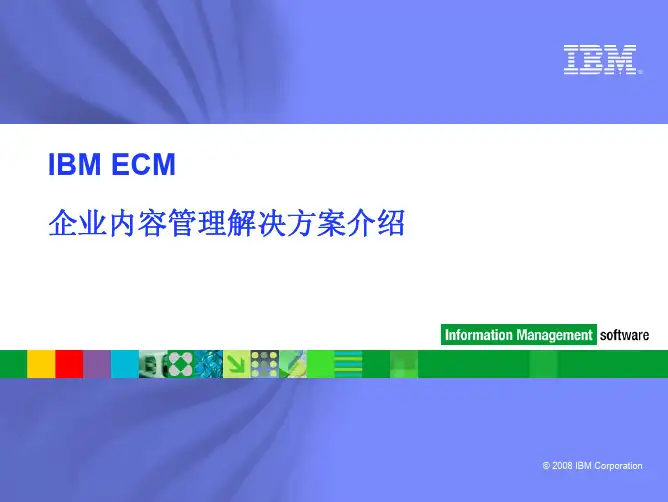
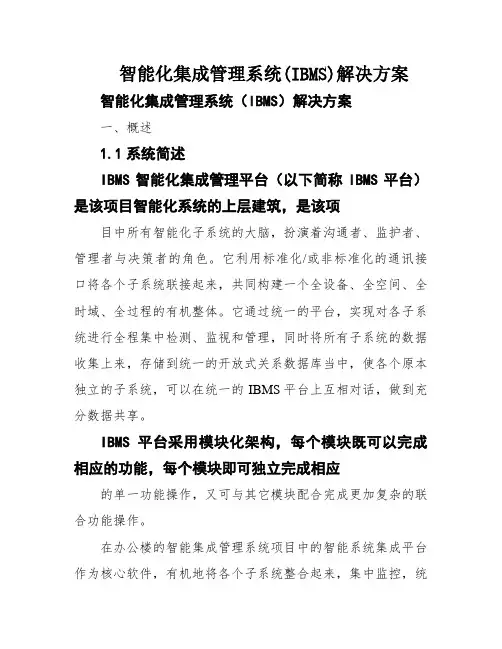
智能化集成管理系统(IBMS)解决方案智能化集成管理系统(IBMS)解决方案一、概述1.1系统简述IBMS智能化集成管理平台(以下简称IBMS平台)是该项目智能化系统的上层建筑,是该项目中所有智能化子系统的大脑,扮演着沟通者、监护者、管理者与决策者的角色。
它利用标准化/或非标准化的通讯接口将各个子系统联接起来,共同构建一个全设备、全空间、全时域、全过程的有机整体。
它通过统一的平台,实现对各子系统进行全程集中检测、监视和管理,同时将所有子系统的数据收集上来,存储到统一的开放式关系数据库当中,使各个原本独立的子系统,可以在统一的IBMS平台上互相对话,做到充分数据共享。
IBMS平台采用模块化架构,每个模块既可以完成相应的功能,每个模块即可独立完成相应的单一功能操作,又可与其它模块配合完成更加复杂的联合功能操作。
在办公楼的智能集成管理系统项目中的智能系统集成平台作为核心软件,有机地将各个子系统整合起来,集中监控,统一管理,使它们协调工作,共同为办公楼创造一个舒适、便捷、绿色、安全的办公、购物、休闲环境。
在办公楼的智能集成管理体系项目中,我司将充分考虑项目每一项目前详细需求,同时兼顾未来发展,IBMS集成管理平台预留其他体系接口功能,以便该项目后期项目子体系及其他的分站可接入IBMS集成管理平台主体系。
充分发挥IBMS 的特点与优势,使得IBMS一次投入,毕生享用。
1.2设计目标1.2.1扁平结构IBMS在确保能够与各种常用标准化数据通讯接口可靠进行数据交换的同时,又能利用特有的专利技术(规约适配器)与各类标准/或非标数据通讯接口直接进行对话,完成其与各子系统的信息交换和通讯协议转换。
尽量将整个系统结构扁平化,减少数据通讯的中间环节,提高数据通讯速度与可靠性,降低故障率。
1.2.2集中协调IBMS把各种子系统集成为一个“有机”的统一系统,实现五个方面的功能集成:所有子系统信息的集成和综合管理,对所有子体系的集中监视和控制,全局事件的管理,流程自动化管理。
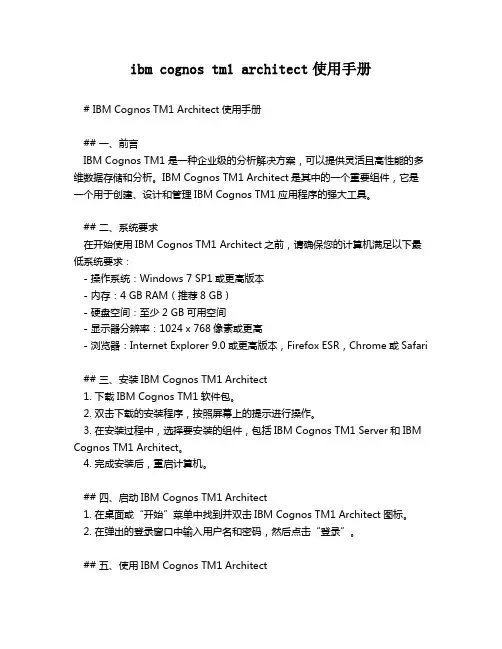
ibm cognos tm1 architect使用手册# IBM Cognos TM1 Architect使用手册## 一、前言IBM Cognos TM1 是一种企业级的分析解决方案,可以提供灵活且高性能的多维数据存储和分析。
IBM Cognos TM1 Architect是其中的一个重要组件,它是一个用于创建、设计和管理IBM Cognos TM1应用程序的强大工具。
## 二、系统要求在开始使用IBM Cognos TM1 Architect之前,请确保您的计算机满足以下最低系统要求:- 操作系统:Windows 7 SP1或更高版本- 内存:4 GB RAM(推荐8 GB)- 硬盘空间:至少2 GB可用空间- 显示器分辨率:1024 x 768像素或更高- 浏览器:Internet Explorer 9.0或更高版本,Firefox ESR,Chrome或Safari## 三、安装IBM Cognos TM1 Architect1. 下载IBM Cognos TM1软件包。
2. 双击下载的安装程序,按照屏幕上的提示进行操作。
3. 在安装过程中,选择要安装的组件,包括IBM Cognos TM1 Server和IBM Cognos TM1 Architect。
4. 完成安装后,重启计算机。
## 四、启动IBM Cognos TM1 Architect1. 在桌面或“开始”菜单中找到并双击IBM Cognos TM1 Architect图标。
2. 在弹出的登录窗口中输入用户名和密码,然后点击“登录”。
## 五、使用IBM Cognos TM1 Architect### 5.1 创建模型1. 在左侧导航栏中,右键单击“模型”,然后选择“新建模型”。
2. 在弹出的对话框中,输入模型的名称和描述,然后点击“确定”。
### 5.2 设计维度1. 在左侧导航栏中,展开模型,右键单击“维度”,然后选择“新建维度”。
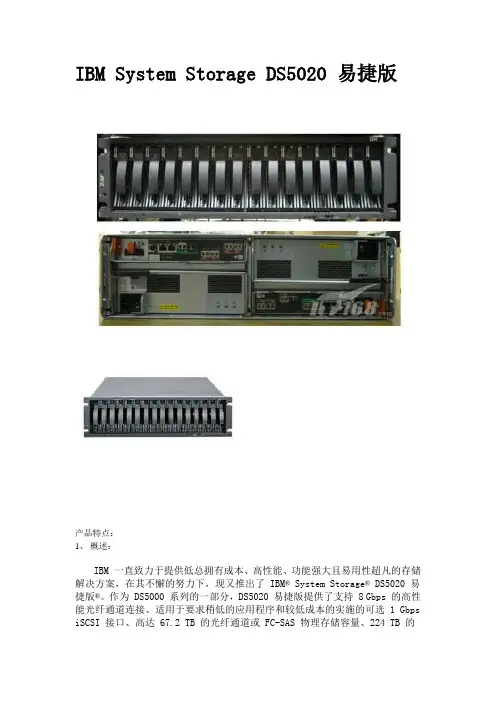
IBM System Storage DS5020 易捷版产品特点:1、概述:IBM 一直致力于提供低总拥有成本、高性能、功能强大且易用性超凡的存储解决方案,在其不懈的努力下,现又推出了IBM® System Storage® DS5020 易捷版®。
作为 DS5000 系列的一部分,DS5020 易捷版提供了支持 8 Gbps 的高性能光纤通道连接、适用于要求稍低的应用程序和较低成本的实施的可选 1 Gbps iSCSI 接口、高达 67.2 TB 的光纤通道或 FC-SAS 物理存储容量、224 TB 的SATA 物理存储容量、33.6 TB SSD 物理存储容量以及强大的系统管理、数据管理和数据保护功能。
凭借 EXP520 扩展单元,DS5020 易捷版可连接多达 6 个光纤通道扩展单元,从而将容量从工作组级扩展到企业级。
要点∙新一代8 Gbps 光纤通道接口支持基础架构简化∙混合主机接口支持(光纤通道/iSCSI)可实现SAN 分层∙均衡的性能非常适合于虚拟化/整合∙支持低耗电的超高速固态磁盘(SSD)∙整合成本更低∙自加密驱动器可在驱动器的整个生命周期内保护数据安全∙支持混用光纤通道/FC-SAS/SED/SATA/SSD 驱动器可实现经济高效的分层存储∙值得信赖的存储系统,可随需保护并提供数据∙功能丰富的管理软件可最大限度地提高利用率并降低存储总拥有成本∙应用程序证书带来信心保证∙Central management of the DS3000 and DS5000 series with the IBM System Storage DS® Storage Manager∙通过连接6 个EXP520 扩展单元,可支持多达112 个磁盘驱动器模块更高效地管理数据最优化的数据管理需要数据可用性高、存储管理能力强大、性能超凡的存储解决方案。
IBM 推出了IBM System Storage® DS5020 易捷版®,旨在提供更低总拥有成本、高性能、强大功能和无与伦比的易用性。
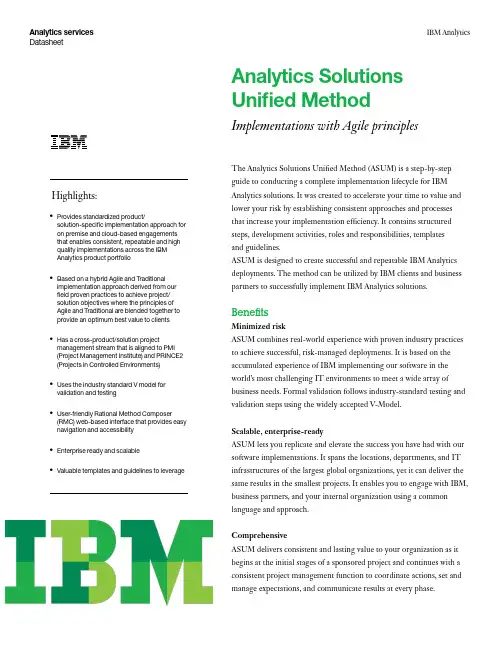
The Analytics Solutions Unified Method (ASUM) is a step-by-step guide to conducting a complete implementation lifecycle for IBMAnalytics solutions. It was created to accelerate your time to value and lower your risk by establishing consistent approaches and processes that increase your implementation efficiency. It contains structured steps, development activities, roles and responsibilities, templates and guidelines.ASUM is designed to create successful and repeatable IBM Analytics deployments. The method can be utilized by IBM clients and business partners to successfully implement IBM Analytics solutions.BenefitsMinimized riskASUM combines real-world experience with proven industry practices to achieve successful, risk-managed deployments. It is based on the accumulated experience of IBM implementing our software in the world’s most challenging IT environments to meet a wide array of business needs. Formal validation follows industry-standard testing and validation steps using the widely accepted V-Model.Scalable, enterprise-readyASUM lets you replicate and elevate the success you have had with our software implementations. It spans the locations, departments, and IT infrastructures of the largest global organizations, yet it can deliver the same results in the smallest projects. It enables you to engage with IBM, business partners, and your internal organization using a common language and approach.ComprehensiveASUM delivers consistent and lasting value to your organization as it begins at the initial stages of a sponsored project and continues with a consistent project management function to coordinate actions, set and manage expectations, and communicate results at every phase.Analytics Solutions Unified MethodImplementations with Agile principlesHighlights:• Provides standardized product/solution-specific implementation approach foron premise and cloud-based engagements that enables consistent, repeatable and high quality implementations across the IBM Analytics product portfolio• Based on a hybrid Agile and Traditionalimplementation approach derived from our field proven practices to achieve project/ solution objectives where the principles of Agile and Traditional are blended together to provide an optimum best value to clients• Has a cross-product/solution projectmanagement stream that is aligned to PMI (Project Management Institute) and PRINCE2 (Projects in Controlled Environments)• Uses the industry standard V model forvalidation and testing• User-friendly Rational Method Composer(RMC) web-based interface that provides easy navigation and accessibility• Enterprise ready and scalable•Valuable templates and guidelines to leverageIt then continues beyond the initial implementation by incorporating the “Operate & Optimize” phase to iteratively tune and improve the solution.Product-specific implementation roadmapsBecause design, configuration and deployment procedures vary according to product line or technology, IBM Analytics has developed different product or solution-specific implementation roadmaps. These guide you through procedures to address the varying tasks, activities, and user needs. Prototyping sprints and iterative and incremental development are used where applicable.Phases and deliverablesASUM follows five fully defined phases. Each phase is overseen by a project management stream that ensures consistent and coordinated communication and collaboration.ASUM and agileASUM uses a hybrid of agile and traditional implementation principles to achieve your solution objectives and provide an optimal result to your organization. These principles include: • Project is assessed for the application of agile principles • Project is scoped and initial business requirementsare gathered• Both business and IT personnel form an integral part of the project implementation team• Requirements are clarified and fine-tuned through a number of iterative prototyping sprints• Based on the number and priority of requirements, timeline and available resources, a staged implementation approach is adopted to achieve the objectives• Prototyping results are then compared to total requirements to assess achievements and determine further iterations • Iterative and incremental development is used to finalizeconfiguration and build• Following adequate testing performed throughout the life cycle of the project, the first stage of the solution goes live • Remaining stages of the project follow the same path ofprototyping sprints and iterative and incrementaldevelopment as the first stage• Implemented stages’ outcomes are continuously monitored in the “Operate & Optimize” phase and if deviations occur then further rounds of development could take placePhase OverviewAnalyze Define what the solution needs to accomplish, both interms of features and non-functional attributes(performance, usability, etc.). Obtain agreement betweenall parties about these requirements.Design Define all solution components and their dependencies,identify resources, and install a development environment.Iterative Prototyping Sprints are used when applicable toclarify requirements.Configure& BuildConfigure, build, and integrate components based onan Iterative and incremental approach. Utilizesmulti- environment testing and validation plan basedon the V-model.Deploy Create a plan to run and maintain the solution, includinga support schedule. Migrate to Production environment,configure as necessary, and communicate the deploymentto the business user audience.Operate& OptimizeRepresent the use of the IBM Analytics solution. Operateincludes the maintenance tasks and checkpoints after rollout that facilitate a successful employment of the solutionand preserve its health.ProjectManagementConsists of processes which assist with managing andmonitoring the progress and maintenance of the project.Figure 1: Analytics Solutions Unified Method (ASUM).Source: IBM Corporation.2AS00082-USEN-00© Copyright IBM Corporation 2016IBM Corporation New Orchard Road Armonk, NY 10504Produced in the United States of America March 1, 2016IBM, the IBM logo and are trademarks ofInternational Business Machines Corp., registered in many jurisdictions worldwide. Other product and service names might be trademarks of IBM or other companies. A current list of IBM trademarks is available on the Web at “Copyright and trademark information”at: /legal/copytrade.shtmlThis document is current as of the initial date of publication and may be changed by IBM at any time. Not all offerings are available in every country in which IBM operates.THE INFORMATION IN THIS DOCUMENT IS PROVIDED “AS IS” WITHOUT ANY WARRANTY, EXPRESS OR IMPLIED, INCLUDING WITHOUT ANY WARRANTIES OF MERCHANTABILITY, FITNESS FOR A PARTICULAR PURPOSE AND ANY WARRANTY OR CONDITION OF NON-INFRINGEMENT . IBM products are warranted according to the terms and conditions of the agreements under which they are provided.The client is responsible for ensuring compliance with laws and regulations applicable to it. IBM does not provide legal advice or represent or warrant that its services or products will ensure that the client is in compliance with any law or regulation.Please RecycleAvailabilityFree client versions of these implementation roadmaps are available through the ASUM Web site. Additional ASUM material can be obtained through a services engagement with IBM Analytics Services.About IBM Analytics ServicesThe Analytics Services organization provides expert servicesexclusively focused on the IBM Analytics product portfolio. Our depth of experience and extensive proven practices help clients mitigate risks, raise the quality of their implementations and build valuable skills. We have provided guidance, advice, reviews, assessments and assistance to thousands of clients around the world enabling them to maximize the return on investment for both their on premise and cloud based analytics solutions.About IBM AnalyticsIBM Analytics delivers actionable insights decision-makers need to achieve better business performance. IBM Analytics offers acomprehensive, unified portfolio of business intelligence, predictive and advanced analytics, financial performance and strategy management, governance, risk and compliance and analytic applications.With IBM software, companies can spot trends, patterns andanomalies, compare “what if” scenarios, predict potential threats and opportunities, identify and manage key business risks and plan, budget and forecast resources. With these deep analytic capabilities our customers around the world can better understand, anticipate and shape business outcomes.Request a callT o request a call or to ask a question, send an e-mail to:***************.com . An IBM representative will respond to your inquiry as soon as possible.For more information• Visit our Services Web site: /analytics /services • Find us on Facebook: bit.ly/Analytics_Skills_FB• Subscribe to our Y ouT ube Channel: bit.ly/Y ouT ubeAnalyticsSkills • T witter:@IBMAnalyticSvcs。

XXX公司BI系统方案建议书IBM公司软件部二〇二一年八月目录第一章概述随着市场竞争的日趋猛烈,各家公司纷纷把提高决策的科学性、合理性提高到一个新的熟悉高度。
在此背景下,利用信息技术的最新手腕,利用业务数据进行面向决策的分析这一方式纷纷被国内外许多公司所采纳。
通过有目的、有选择地搜集业务数据,并将其转换为对决策有效的信息,用于智能化的分析、预测和模拟等目的,如此的应用被称为商业智能应用。
从国内外各行各业的进展体会看,实施商业智能是提高企业进行高效的业务分析和科学决策的有效手腕。
作为一个具有八十连年历史,以开发信息技术和商业应用而闻名的“蓝色巨人”,IBM 在这一领域进行了连年的研究,进展出完备的商业智能技术,为商业数据自动转化为商业知识提供了现实的方案。
商业智能的本质,是提取搜集到的数据,进行智能化的分析,揭露企业运作和市场情形,帮忙治理层做出正确明智的经营决定。
一样现代化的业务操作,通常都会产生大量的数据,如话单、账单和客户资料等,其中一部份是决策关键数据,但并非是所有的数据都对决策有决定意义。
商业智能包括搜集、清理、治理和分析这些数据,将数据转化为有效的信息,然后及时分发到企业遍地,用于改善业务决策。
企业能够利用它的信息和结论进行加倍灵活的时期性的决策:如采纳什么产品、针对哪类客户、如何选择和有效地推出效劳等等,也能够实现高效的财务分析、销售分析、风险治理、分销和后勤治理等等。
这一切都是为了降低本钱、提高利润率和扩大市场分额。
第二章商业智能综述2.1 商业智能大体结构现今,许多企业熟悉到只有靠充分利用,挖掘其现有数据,才能实现更大的商业效益。
日常的商务应用生成了大量的数据,这些数据假设用于决策支持那么会带来显著的附加值。
假设再加上市场分析报告、独立的市场调查、质量评测结果和顾问评估等外来数据时,上述处置进程产生的效益可进一步增强。
而数据仓库正是汇总这些商用信息后,进而支持数据挖掘、多维数据分析等现今尖端技术和传统的查询及表报功能,这些关于在现今猛烈的商业竞争中维持领先是相当重要的。

IBM企业内容管理解决方案企业内容管理(Enterprise Content Management,ECM)是指一套用于管理企业信息资产的综合的解决方案。
具体而言,ECM包括了创建、收集、存储、检索、分发和管理企业信息的一系列技术和流程。
IBM作为全球领先的技术解决方案提供商,提供了一系列强大的企业内容管理解决方案,帮助企业实现信息资产的高效管理和利用。
IBM的企业内容管理解决方案主要包括以下几个方面:1. IBM FileNet Content Manager:IBM FileNet Content Manager是一种企业级内容管理系统,用于帮助企业管理其各种类型的信息和文档。
它提供了一套全面的功能,包括文档管理、工作流管理、记录管理、数字资产管理等。
通过FileNet Content Manager,企业可以轻松地管理和共享文档,提高工作效率和信息的可靠性。
2. IBM Datacap:IBM Datacap是一种智能文档识别和数据捕获解决方案,可以帮助企业自动化其文档处理流程。
通过Datacap,企业可以快速准确地捕获、识别和处理各种类型的文档内容,从而提高工作效率和降低人工成本。
3. IBM Content Navigator:IBM Content Navigator是一种用于访问和管理企业信息资源的统一界面解决方案。
它可以将不同的信息资源整合在一个统一的界面中,提供统一的访问和管理功能。
通过Content Navigator,用户可以轻松地查找、浏览和协作文档,实现信息的高效利用。
4. IBM Case Manager:IBM Case Manager是一种用于管理业务流程和协作的解决方案,可以帮助企业更高效地管理和处理其业务案例。
通过Case Manager,企业可以创建、分析和优化其业务流程,实现信息资源的集成和协作,提高业务效率和客户满意度。
5. IBM StoredIQ:IBM StoredIQ是一种用于存储管理和信息分析的解决方案,可以帮助企业管理其存储环境和了解其信息资产。
要点■4 Gbps 光通道接口技术■配备DS3000 Storage Manager ,便于部署和管理■采用300GB 热插拔SAS 磁盘,存储容量可扩展到3.6TB面向中小企业的简便、可扩展、灵活、经济的外置存储解决方案IBM System Storage DS3400随着企业的发展壮大, 企业内部的数据数量及其包含的价值也在不断增加。
如果数据分布在各个服务器和存储系统中, 企业将面临成本、复杂性及随之而来的业务风险。
IBM System Storage ™ DS3400可帮助这些企业利用直连和SAN 解决方案中的数据整合与共享优势。
DS3400可使企业在简便、经济的磁盘系统中满足数据扩展、数据可用性和灵活性需求。
■最多可连接3个EXP3000,使总存储容量可扩展到14.4TB ■可灵活使用IBM System x TM 和BladeCenter ®服务器■中小企业预算可承受的价格IBM System Storage ™|您身边的系统存储专家便于部署和管理鉴于大多数小型企业的IT部门只有一个管理员, 甚至只有兼职管理员, 他们仅有有限的时间用于数据管理, DS3400安装简便, 不需要精深的知识, 也不需要投入大量精力。
即使缺乏经验的管理员也可轻松安装DS3000 Storage Manager软件。
DS3000 Storage Manager面向任务的管理界面首先向管理员提交任务, 然后询问将由哪个对象执行任务。
而一般系统的面向对象的界面恰好相反, 在此类系统中, 首先选择对象, 然后选择任务, 这需要管理员掌握精湛的存储网络技术。
而对于DS3000 Storage Manager, 即使非Storage管理员也可快速安装和部署存储解决方案。
这一管理应用程序的面向任务的界面消除了许多企业因内部技能有限而造成的障碍。
可利用多个EXP3000进行扩展DS3400的可扩展性使IT管理员能够响应不断变化的存储环境。
数据仓库实施方案一、引言数据仓库是指将组织在操作型数据库系统中分散存储的海量数据进行抽取、转换、加载后,存储在一个统一的数据仓库中,以支持企业决策分析和提供全面的商业智能服务。
本文将提出一个数据仓库的实施方案。
二、确定需求在实施数据仓库之前,需要明确业务需求和目标。
通过与企业相关部门的沟通和理解,确定数据仓库的范围、目标和功能要求,包括数据仓库所需的数据源、数据模型和分析需求等。
三、架构设计基于需求分析的结果,进行数据仓库的架构设计。
数据仓库的架构应该包括数据源抽取、数据转换、数据加载和数据存储等四个主要模块。
1.数据源抽取:通过连接数据源,抽取数据并进行数据清洗和筛选,确保抽取的数据质量和准确性。
可以采用ETL工具来实现数据源抽取。
2.数据转换:将抽取的数据进行转换,包括数据清洗、数据集成、数据变换和数据聚合等。
通过数据转换,将数据转化为符合数据仓库的模型和标准。
3.数据加载:将转换后的数据加载到数据仓库中,可以采用增量加载或全量加载的方式。
同时,需要设计合适的数据存储结构和索引,以提高数据的查询效率。
4.数据存储:选择合适的数据存储方式,包括关系型数据库、多维数据库和分布式文件系统等。
根据实际需求和数据量大小,进行适当的优化和扩展。
四、技术选型在实施数据仓库时,需要选择合适的技术工具和平台。
主要包括以下方面:1. 数据抽取和转换工具:选择成熟稳定的ETL工具,如Informatica PowerCenter或IBM DataStage,用于实现数据源抽取和转换。
2. 数据库管理系统:选择可靠、高性能的数据库管理系统,如Oracle、SQL Server或Teradata等。
根据数据量和性能要求,选择合适的数据库类型。
3. 数据质量工具:选择数据质量工具,用于数据清洗、校验和提高数据的准确性。
例如,Informatica Data Quality或IBM InfoSphere QualityStage等。
IBM TSM 标准方案说明目录1. 概述 (3)2 需求分析 (3)2.1 面临的问题 (3)2.1.1 日常的数据备份管理 (3)2.1.2 重要文件的定期归档 (4)2.1.3 分级存储管理 (4)2.1.4 存储介质管理 (4)2.1.5 数据库应用的在线备份 (4)2。
1.6 系统灾难恢复 (4)2.1.7 SAN环境下存储资源的管理 (4)2。
1.8 支持移动和远程客户机 (5)2。
2 备份管理系统的需求 (5)3. 方案综述 (6)3。
1 IBM与Tivoli (6)3。
2 Tivoli TSM备份方案使客户具有: (7)3.2.1 统一的备份策略 (7)3.2.2 可靠的自动备份管理 (7)3.2。
3 跨平台网络备份 (7)3.2.4 快速恢复 (8)3。
2.5 重要文件的定期归档 (8)3。
2。
6 分级存储管理 (8)3。
2。
7 存储介质有效管理 (8)3.2。
8 应用数据库的在线备份 (8)3.2。
9 系统灾难恢复 (8)3。
2。
10SAN的存储资源共享83。
2.11 重要数据备份多份(克隆) (9)3.3 Tivoli TSM备份管理系统的优势: (9)3。
3.1 基于统一策略的备份管理 (9)3.3。
2 安全的备份管理 (9)3.3.3 完善的数据保护措施 (9)3。
3。
4 真正的自动化管理 (10)3.3.5 操作简单 (10)3.3。
6 扩展性 (10)3。
4 备份管理解决方案: (11)3。
4。
1 方案设计原则 (11)3。
4.2 TSM备份管理方案及功能 (12)3.4。
2。
1 应用数据的全自动备份 (12)3。
4。
2。
2 制定备份策略 (12)3。
4。
2。
3 磁带的管理 (13)3.4。
2。
4 历史数据归档 (14)3。
4.2.5分级存储管理 (14)3。
4.2。
6对介质的有效管理 (15)3.4。
2。
7实现数据管理的自动恢复 (15)3。
4.2。
8实现数据库的在线备份 (15)3。